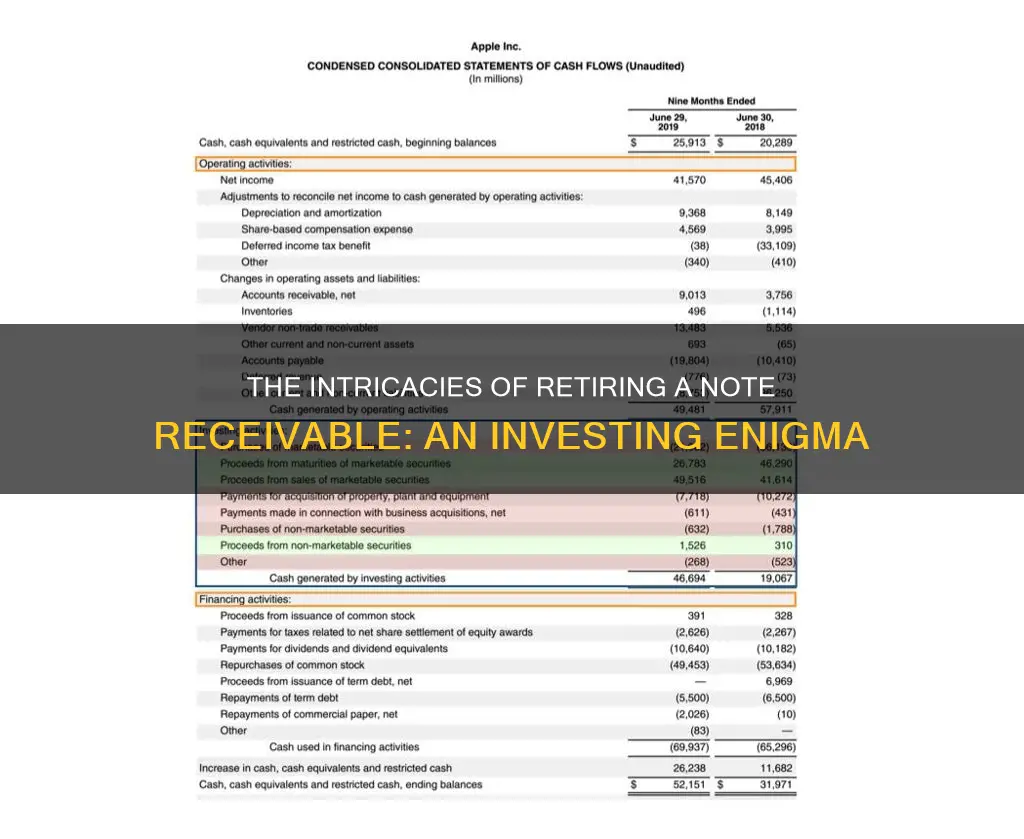
Notes receivable are a balance sheet item that records the value of promissory notes that a business is owed and should receive payment for. They are created when a customer needs more time to pay for a sale than the standard billing terms. In such cases, companies may allow customers to convert their overdue accounts into notes receivable, giving them more time to pay. Notes receivable are recorded as an asset on a company's balance sheet and the related interest income is recorded on its income statement. They are classified as either current or long-term assets, depending on whether they are due within a year or not. Notes receivable are important for businesses as they can improve cash flow, increase collectability of amounts owed, and generate revenue in the form of interest.
What You'll Learn

Notes receivable are a balance sheet item
Notes receivable are recorded as an asset on a company's balance sheet. They are usually created when a customer needs more time to pay for a sale than the standard billing terms. The business agrees to slower payment in exchange for interest on the amount owed. The customer or client signs a promissory note, which acts as a legal contract between the client and the business.
The portion of the note receivable due to be repaid within one year is classified as a current asset on the balance sheet, and any amount due beyond that is classified as a long-term asset. The interest income on notes receivable is recognised on the income statement. Therefore, when payment is made on a note receivable, both the balance sheet and the income statement are affected.
Notes receivable are beneficial to businesses as they improve cash flow and increase the likelihood of receiving payment. They are also useful to customers as they provide more time to pay.
Wealthy Secrets: Investment Trends
You may want to see also

They are recorded at the present value of all future cash flows
Notes receivable are a type of asset account that records the value of promissory notes that a business is owed and should receive payment for. They are recorded at the present value of all future cash flows, which is calculated as the sum of money that would need to be deposited today, at a given interest rate, to result in a specified future amount at maturity. This is known as the net present value or discounted cash flow.
A promissory note is a written promise to pay cash to another party on or before a specified future date. It is a formal, unconditional and legally binding agreement. When a promissory note is accepted, a business records the amount due as a note receivable on its balance sheet. The related interest income is recorded on its income statement.
Notes receivable can arise from loans, advances to employees, or from customers who need to extend the payment period of an outstanding account. They can also be used for sales of property, plant and equipment, or for exchanges of long-term assets.
Notes receivable are usually classified as either short-term (current) or long-term assets. Short-term notes are those that will be paid off within the next twelve months, or within the business's operating cycle if longer than twelve months. Long-term notes are those with due dates greater than one year.
The initial recognition of a note receivable is at its fair value on the date that the note is legally executed, usually upon signing. Subsequent valuation is measured at amortised cost.
The Accounting Treatment: Gain on Retirement of Debt and its Impact on Investing Activities
You may want to see also

They are treated as a current asset if due within a year
Notes receivable are a type of asset account that businesses use to record the value of promissory notes that they are owed and are expecting to receive payment for. A promissory note is a written promise to pay cash to another party on or before a specified future date.
When a promissory note is accepted, a business records the amount due as a note receivable. The note receivable "maker" (usually the customer) gets extra time to pay, while the note holder receives interest income.
Notes receivable are treated as a current asset if they are due within a year. If the note is not due until a date that is more than a year in the future, it is treated as a non-current asset. The portion of the note receivable due to be repaid within one year is classified as a current asset, and any amount beyond that is classified as a long-term asset.
For accounting purposes, a payee records a note receivable as an asset on its balance sheet and the related interest income on its income statement. The interest income on notes receivable is recognised on the income statement, so when payment is made on a note receivable, both the balance sheet and the income statement are affected.
Reliance Industries: Invest Now?
You may want to see also

If not due within a year, they are treated as a non-current asset
Notes receivable are a balance sheet item that records the value of promissory notes that a business is owed and should receive payment for. A written promissory note gives the holder, or bearer, the right to receive the amount outlined in the legal agreement. Promissory notes are a written promise to pay cash to another party on or before a specified future date.
If the note receivable is due within a year, then it is treated as a current asset on the balance sheet. If it is not due until a date that is more than one year in the future, then it is treated as a non-current asset on the balance sheet.
The portion of the note receivable due to be repaid within one year is classified as a current asset, and any amounts beyond that are classified as long-term. The interest income on notes receivable is recognised on the income statement. Therefore, when payment is made on a note receivable, both the balance sheet and the income statement are affected.
Notes receivable can be classified as current or long-term assets or both. Amounts due within 12 months are classified as short-term and any amounts beyond that are classified as long-term.
A note receivable is an asset account tied to an underlying promissory note, which details in writing the payment terms for a purchase between a “payee” (typically a company, and sometimes called a creditor) and the “maker” of the note (usually a customer or employee, and sometimes called a debtor). Notes receivable can be between a business and any other party, including another business, a financial institution, or an individual.
Capacity Investment: Finding the Right Formula
You may want to see also

Notes receivable are recognised as an asset on the balance sheet
When a promissory note is accepted, a business records the amount due on its accounting books as a note receivable, meaning an asset. The note receivable is an asset account tied to an underlying promissory note, which details the payment terms for a purchase. The promissory note is a written promise to pay cash to another party on or before a specified future date.
The key components of a note receivable are the principal value, the maker, the payee, the stated interest, and the timeframe. The principal value is the face value of the note, while the maker is the person who makes the note and promises to pay the note holder. The payee is the person who holds the note and is due to receive payment from the maker. The stated interest is the predetermined interest rate that the maker is obligated to pay, in addition to the principal amount. Finally, the timeframe is the length of time during which the note is to be repaid.
Notes receivable are usually recorded as current assets on the balance sheet if they are due within a year. If the due date is more than a year in the future, they are treated as non-current assets. The interest income on notes receivable is recognised on the income statement, so when payment is made, both the balance sheet and the income statement are affected.
Whole Life Insurance: Paying for Protection or Investing in a Policy?
You may want to see also
Frequently asked questions
A note receivable is a balance sheet item that records the value of a promissory note that a business is owed and should receive payment for. It is a written promise to pay cash to another party on or before a specified future date.
Notes receivable are accepted from customers who need to extend the payment period over which a receivable is repaid. A promissory note is created, which outlines the promise to repay a prescribed amount of money at, or over, a predetermined timeframe.
Notes receivable are recorded as an asset on a company's balance sheet. If the note is due within a year, it is treated as a current asset. If it is due after a year, it is treated as a non-current or long-term asset.







